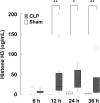Circulating histone H3 levels are increased in septic mice in a neutrophil-dependent manner: preclinical evaluation of a novel sandwich ELISA for histone H3
- PMID: 30505450
- PMCID: PMC6260889
- DOI: 10.1186/s40560-018-0348-y
Circulating histone H3 levels are increased in septic mice in a neutrophil-dependent manner: preclinical evaluation of a novel sandwich ELISA for histone H3
Abstract
Background: Nuclear histone proteins are released into the extracellular space during sepsis and act as major mediators of death. However, circulating histone levels have not been precisely quantified.
Methods: We developed a novel enzyme-linked immunosorbent assay (ELISA) for detection of circulating histone H3 levels and evaluated its performance. Using the ELISA, we measured plasma histone H3 levels in C57BL/6 J mice subjected to cecal ligation and puncture (CLP)-induced sepsis.
Results: The newly developed ELISA enabled reproducible measurement of histone H3 levels with a working range up to 250 ng/mL. Using the ELISA, we found that plasma histone H3 levels were elevated in septic mice compared with sham-operated mice (p < 0.01). The elevation of histone H3 levels was abrogated when neutrophils were depleted (p < 0.01).
Conclusions: Our novel ELISA provides reproducible measurements of histone H3 levels. Circulating histone H3 levels are increased in septic mice in a neutrophil-dependent manner. Further studies are needed to evaluate the clinical utility of histone H3 levels in patients with sepsis.
Keywords: ELISA; Histone; Neutrophil; Sepsis.
Conflict of interest statement
All experiments involving animals were approved by the Institutional Animal Care and Use Committee of Kagoshima University.Not applicable.The ELISA for histone H3 is a product in development of Shino-Test Corporation where SO and SY are employed. IM holds an endowed chair at Kagoshima University and received a research fund from Shino-Test Corporation. The fund is for academic promotion and is not directly related to this study. The remaining authors declare that they have no competing interests.Springer Nature remains neutral with regard to jurisdictional claims in published maps and institutional affiliations.
Figures




References
LinkOut - more resources
Full Text Sources
Miscellaneous

